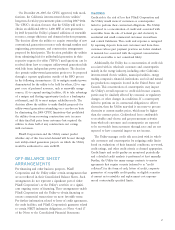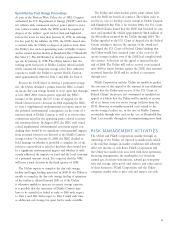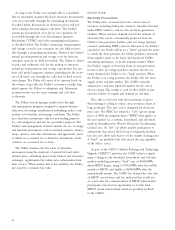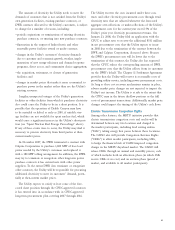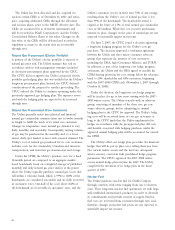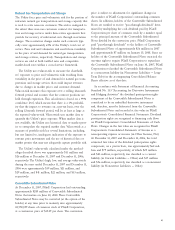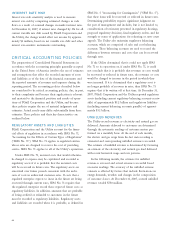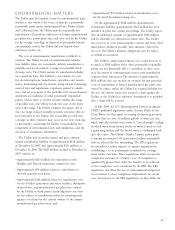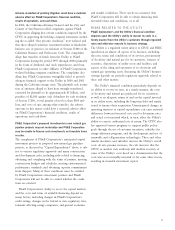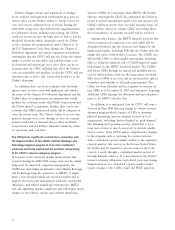PG&E 2007 Annual Report Download - page 66
Download and view the complete annual report
Please find page 66 of the 2007 PG&E annual report below. You can navigate through the pages in the report by either clicking on the pages listed below, or by using the keyword search tool below to find specific information within the annual report.64
INTEREST RATE RISK
Interest rate risk sensitivity analysis is used to measure
interest rate risk by computing estimated changes in cash
fl ows as a result of assumed changes in market interest rates.
At December 31, 2007, if interest rates changed by 1% for all
current variable rate debt issued by PG&E Corporation and
the Utility, the change would affect net income by approxi-
mately $3 million, based on net variable rate debt and other
interest rate-sensitive instruments outstanding.
CRITICAL ACCOUNTING POLICIES
The preparation of Consolidated Financial Statements in
accordance with the accounting principles generally accepted
in the United States of America involves the use of estimates
and assumptions that affect the recorded amounts of assets
and liabilities as of the date of the fi nancial statements and
the reported amounts of revenues and expenses during the
reporting period. The accounting policies described below
are considered to be critical accounting policies, due, in part,
to their complexity and because their application is relevant
and material to the fi nancial position and results of opera-
tions of PG&E Corporation and the Utility, and because
these policies require the use of material judgments and
estimates. Actual results may differ substantially from these
estimates. These policies and their key characteristics are
outlined below.
REGULATORY ASSETS AND LIABILITIES
PG&E Corporation and the Utility account for the fi nan-
cial effects of regulation in accordance with SFAS No. 71,
“Accounting for the Effects of Certain Types of Regulation”
(“SFAS No. 71”). SFAS No. 71 applies to regulated entities
whose rates are designed to recover the cost of providing
service. SFAS No. 71 applies to all of the Utility’s operations.
Under SFAS No. 71, incurred costs that would otherwise
be charged to expense may be capitalized and recorded as
regulatory assets if it is probable that the incurred costs
will be recovered in future rates. The regulatory assets are
amortized over future periods consistent with the inclu-
sion of costs in authorized customer rates. If costs that a
regulated enterprise expects to incur in the future are being
recovered through current rates, SFAS No. 71 requires that
the regulated enterprise record those expected future costs as
regulatory liabilities. In addition, amounts that are probable
of being credited or refunded to customers in the future
must be recorded as regulatory liabilities. Regulatory assets
and liabilities are recorded when it is probable, as defi ned in
SFAS No. 5 “Accounting for Contingencies” (“SFAS No. 5”),
that these items will be recovered or refl ected in future rates.
Determining probability requires signifi cant judgment on
the part of management and includes, but is not limited to,
consideration of testimony presented in regulatory hearings,
proposed regulatory decisions, fi nal regulatory orders, and the
strength or status of applications for rehearing or state court
appeals. The Utility also maintains regulatory balancing
accounts, which are comprised of sales and cost balancing
accounts. These balancing accounts are used to record the
differences between revenues and costs that can be recovered
through rates.
If the Utility determined that it could not apply SFAS
No. 71 to its operations or, if under SFAS No. 71, it could
not conclude that it is probable that revenues or costs would
be recovered or refl ected in future rates, the revenues or costs
would be charged to income in the period in which they
were incurred. If it is determined that a regulatory asset is
no longer probable of recovery in rates, then SFAS No. 71
requires that it be written off at that time. At December 31,
2007, PG&E Corporation and the Utility reported regulatory
assets (including current regulatory balancing accounts receiv-
able) of approximately $5.2 billion and regulatory liabilities
(including current balancing accounts payable) of approxi-
mately $5.1 billion.
UNBILLED REVENUES
The Utility records revenue as electricity and natural gas are
delivered. Amounts delivered to customers are determined
through the systematic readings of customer meters per-
formed on a monthly basis. At the end of each month,
the electric and gas usage from the last meter reading is
estimated and corresponding unbilled revenue is recorded.
The estimate of unbilled revenue is determined by factoring
an estimate of the electricity and natural gas load delivered
with recent historical usage and rate patterns.
In the following month, the estimate for unbilled
revenue is reversed and actual revenue is recorded based
on meter readings. The accuracy of the unbilled revenue
estimate is affected by factors that include fl uctuations in
energy demands, weather, and changes in the composition
of customer classes. At December 31, 2007, accrued unbilled
revenues totaled $750 million.





